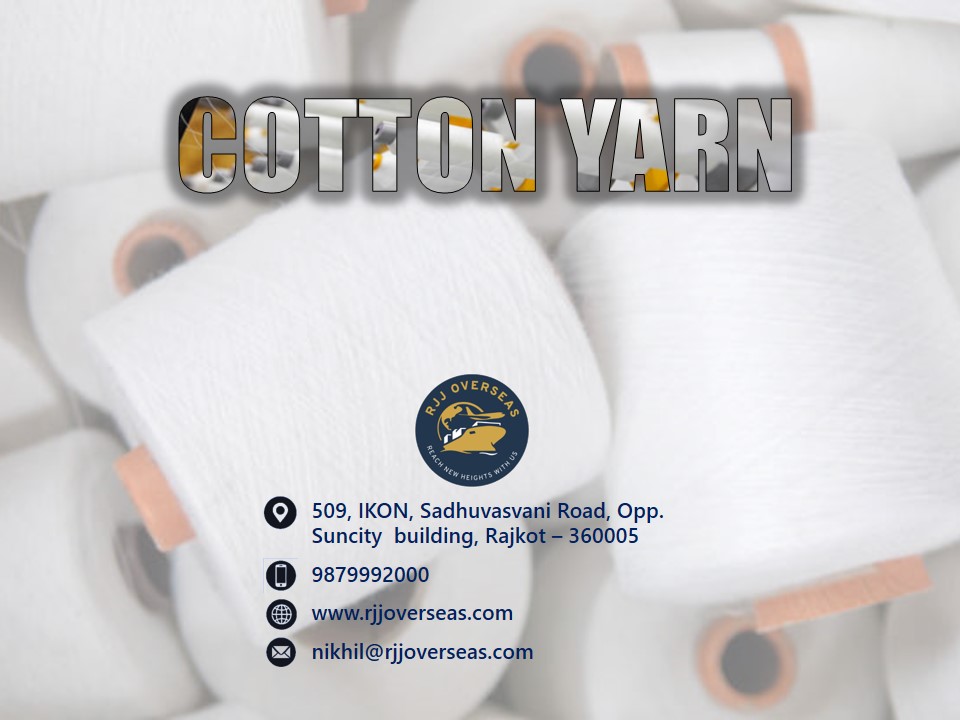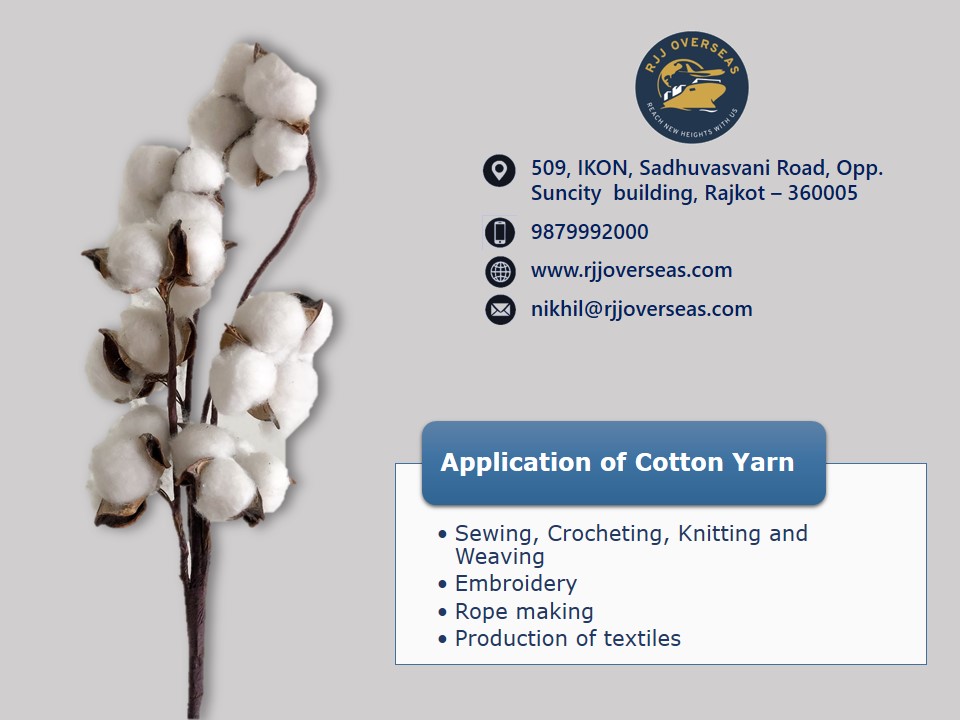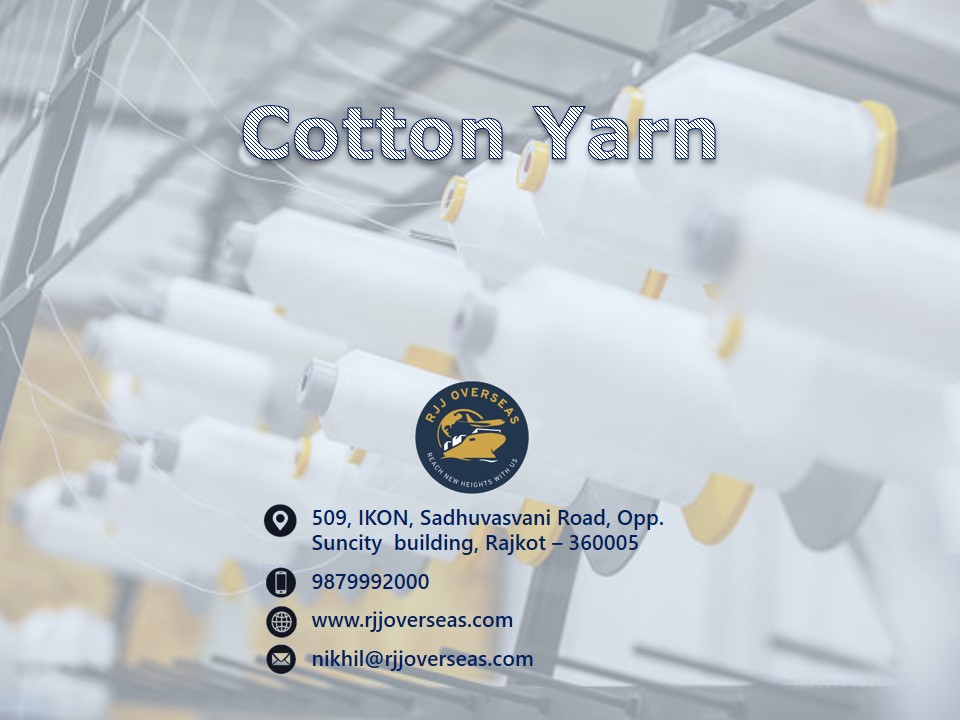Introduction:
India's cotton yarn industry has been experiencing a significant surge in demand in recent years, presenting lucrative opportunities for international textile importers. This blog aims to explore the reasons behind this growing demand and shed light on the various opportunities available in the Indian cotton yarn market. By understanding the factors driving this trend, importers can make informed decisions to maximize their interests in the global textile industry.

Overview of the Indian Cotton Yarn Industry:
The Indian cotton yarn industry is one of the world's largest, known for its superior quality and diverse product range. With cost competitiveness and favorable trade policies, India enjoys a significant market share, making it a lucrative destination for international textile importers.
Providing a comprehensive overview of the Indian cotton yarn industry, including its size, production capacity, and global market share. Highlighting how India's position as one of the largest cotton yarn producers and exporters in the world.
Size and Production Capacity:
The Indian cotton yarn industry boasts substantial size and production capacity, with numerous spinning mills spread across the country. India's annual cotton yarn production capacity exceeds millions of metric tons, making it a significant player in the global market.
Global Market Share:
India holds a prominent position as one of the largest cotton yarn producers and exporters worldwide. Its high-quality yarn and competitive pricing have contributed to capturing a considerable share of the global textile industry.

Leading Producer:
India is recognized as a leading producer of cotton yarn, with a well-established network of spinning mills. The industry's expertise in utilizing advanced machinery, coupled with skilled labor, enables India to meet domestic demands and cater to international markets.
Export Potential:
Indian cotton yarn is highly sought-after in international markets due to its excellent quality and versatility. The country exports a significant portion of its cotton yarn production to various countries, further reinforcing its position in the global market.
Factors Driving the Growing Demand:
The superior quality and versatility of Indian cotton yarn, coupled with its cost competitiveness, are key factors driving the increasing demand in the international textile industry.
- Quality and Diversity:
- Indian cotton yarn is renowned for its superior quality, making it highly sought-after in the international textile industry. The yarn exhibits exceptional strength, durability, and consistency, ensuring longevity and excellent performance in various textile applications.
- Indian manufacturers excel in producing a wide range of cotton yarn types, catering to the diverse requirements of the global market. They possess the expertise and infrastructure to produce different yarn counts, compositions, and finishes, allowing them to meet specific customer demands and industry standards.
- This versatility enables Indian cotton yarn to be used in a broad spectrum of products, including apparel, home textiles, industrial fabrics, and more. Importers benefit from the availability of diverse options, ensuring they can source the ideal yarn type for their specific applications.
b. Cost Competitiveness:
India's cost competitiveness in cotton yarn production plays a significant role in driving its increasing demand. Compared to other major cotton yarn exporting countries, India enjoys lower production costs due to factors like favorable labor costs, economies of scale, and access to abundant raw materials, giving Indian manufacturers a competitive edge.
c. Favorable Trade Policies:
India benefits from various trade policies and agreements that bolster the export of cotton yarn. Preferential trade agreements, duty benefits, and simplified export procedures facilitate smoother trade transactions. These policies create a favorable environment for importers, reducing barriers and costs while encouraging increased engagement in trade with India's cotton yarn industry.
Growing Export Markets:
a. Existing Markets:
Indian cotton yarn enjoys high demand in key markets such as the United States, China, European Union countries, and neighboring Asian nations. These markets offer substantial growth potential. Trade agreements like GSP (Generalized System of Preferences) and regional preferences in certain countries provide advantages to Indian exporters, fostering trade relations and market expansion.
b. Emerging Markets:
Emerging markets, including Africa, Latin America, and Southeast Asia, present promising potential for Indian cotton yarn exports. These regions are experiencing a growing demand for textiles due to factors like population growth, rising disposable incomes, and expanding textile industries. Importers can tap into these markets and capitalize on the untapped opportunities by meeting the increasing demand for quality cotton yarn and establishing strategic partnerships with local manufacturers.
Collaboration and Partnership Opportunities:
Highlighting the scope for collaboration and partnership between Indian cotton yarn manufacturers and international textile importers. Discussing how the advantages of establishing strategic alliances, such as joint ventures, long-term supply contracts, and technology transfer arrangements. Showcasing successful case studies of collaborations that have benefited both Indian manufacturers and international importers.
Collaboration and Partnership Opportunities
Scope for Collaboration:
The Indian cotton yarn industry offers ample scope for collaboration and partnership between Indian manufacturers and international textile importers. This collaboration can yield numerous advantages for both parties involved.
Advantages of Strategic Alliances:
a. Joint Ventures:
Establishing joint ventures allows Indian cotton yarn manufacturers and international importers to leverage their respective strengths and resources. By pooling expertise, technology, and market knowledge, joint ventures can lead to enhanced production capabilities, expanded market reach, and shared risks.
b. Long-Term Supply Contracts:
Long-term supply contracts provide stability and reliability in the procurement of cotton yarn. Indian manufacturers can offer competitive pricing, consistent quality, and on-time delivery, while importers can secure a reliable source of supply for their textile production needs.
c. Technology Transfer Arrangements:
Collaboration can facilitate the transfer of advanced manufacturing technologies and techniques from international importers to Indian manufacturers. This exchange of knowledge can enhance production efficiency, product quality, and innovation in the Indian cotton yarn industry.
Successful Case Studies:
Highlighting successful case studies can illustrate the tangible benefits of collaborations in the Indian cotton yarn industry. For instance:
a. Case Study 1: A joint venture between an Indian cotton yarn manufacturer and a leading textile importer from Europe resulted in the establishment of a state-of-the-art spinning mill in India. This collaboration brought together the technical expertise of the European company and the cost advantages of Indian manufacturing, leading to increased production capacity and market share.
b. Case Study 2: A long-term supply contract between an Indian cotton yarn manufacturer and a renowned apparel brand from the United States ensured a steady supply of high-quality cotton yarn for the brand's textile production. This partnership allowed the brand to maintain consistency in their product offerings, while the Indian manufacturer gained a stable market and increased export volumes.
c. Case Study 3: A technology transfer arrangement between an Indian cotton yarn manufacturer and a textile machinery supplier from Japan facilitated the adoption of advanced spinning technologies in the Indian industry. This collaboration led to improved production efficiency, higher product quality, and enhanced competitiveness in the global market.
These case studies highlight the tangible benefits and successful outcomes that can be achieved through collaborations between Indian cotton yarn manufacturers cum exporters and international importers.
By forging strategic alliances, Indian exporters and international importers can capitalize on each other's strengths, access new markets, drive innovation, and establish long-term partnerships that mutually benefit their interests in the textile industry.
Ensuring Quality Assurance and Compliance:
Addressing importers' concerns regarding quality assurance and compliance with international standards. Explaining how Indian cotton yarn manufacturers adhere to stringent quality control measures, certifications, and sustainable practices. Highlighting the certifications such as ISO, OEKO-TEX, and GOTS that assure importers of the quality and sustainability of Indian cotton yarn.
Ensuring Quality Assurance and Compliance
Importers often have concerns regarding quality assurance and compliance when sourcing cotton yarn from international markets. Indian cotton yarn manufacturers prioritize stringent quality control measures, certifications, and sustainable practices to address these concerns and meet international standards.
Stringent Quality Control Measures:
Indian cotton yarn manufacturers implement comprehensive quality control processes throughout the production cycle. These measures include strict monitoring of raw material sourcing, advanced testing and inspection procedures, and adherence to international quality standards. Stringent quality control ensures consistent and reliable product performance.
Certifications for Quality and Sustainability:
Indian cotton yarn manufacturers obtain various certifications that assure importers of the quality and sustainability of their products. Some prominent certifications include:
a. ISO (International Organization for Standardization): Indian manufacturers often hold ISO 9001 certification, which demonstrates their commitment to quality management systems and continuous improvement.
b. OEKO-TEX Standard 100: This certification ensures that cotton yarn is free from harmful substances and meets strict human-ecological requirements, providing importers with confidence in the safety and integrity of the product.
c. GOTS (Global Organic Textile Standard): GOTS certification guarantees that cotton yarn is produced using organic farming practices, ensuring environmental sustainability and responsible manufacturing processes.

Sustainable Practices:
Indian cotton yarn manufacturers increasingly adopt sustainable practices to meet the growing demand for eco-friendly and socially responsible products. These practices include:
a. Responsible Sourcing: Indian manufacturers source raw cotton from sustainable and certified farms, promoting responsible agricultural practices and reducing the environmental impact.
b. Energy Efficiency: Manufacturers prioritize energy-efficient processes and technologies to minimize energy consumption and reduce carbon emissions.
c. Waste Management: Effective waste management systems, including recycling and reuse initiatives, help minimize waste generation and promote a circular economy approach.
d. Social Compliance: Indian manufacturers comply with social standards, including fair wages, safe working conditions, and ethical labor practices, ensuring a socially responsible supply chain.
Transparent Supply Chain:
Indian cotton yarn manufacturers emphasize transparency in their supply chains, providing importers with visibility into the production process and raw material sourcing. This transparency assures importers of traceability, ethical practices, and adherence to international standards.
By adhering to stringent quality control measures, obtaining relevant certifications, adopting sustainable practices, and ensuring transparency, Indian cotton yarn manufacturers address importers' concerns regarding quality assurance and compliance. These efforts not only meet international standards but also contribute to building trust and long-term partnerships in the global textile industry.
Overcoming Challenges:
Here we are Discussing any challenges or potential risks associated with importing Indian cotton yarn, such as supply chain disruptions, logistics issues, or fluctuations in raw material prices. Providing suggestions and strategies to mitigate these challenges and maintain a sustainable and uninterrupted supply of cotton yarn.
Overcoming Challenges
Importing Indian cotton yarn may come with certain challenges and risks that importers need to be aware of. Addressing these challenges effectively is crucial to maintaining a sustainable and uninterrupted supply of cotton yarn. Here are some common challenges and suggested strategies to mitigate them:
- Supply Chain Disruptions:
Challenge: Disruptions in the supply chain can occur due to various factors, such as natural disasters, political instability, or logistical issues.
Strategy: To mitigate supply chain disruptions, importers can consider the following strategies:
Diversify Suppliers: Work with multiple Indian cotton yarn manufacturers to reduce dependency on a single source.
Maintain Buffer Stock: Maintain an inventory buffer to offset potential delays or disruptions in the supply chain.
Effective Communication: Establish open and transparent communication channels with suppliers to address issues promptly and proactively.
- Logistics Issues:
Challenge: Logistics issues, such as transportation delays, customs clearance complexities, and documentation requirements, can impact the timely delivery of cotton yarn.
Strategy: Importers can adopt the following strategies to mitigate logistics challenges:
Partner with Reliable Freight Forwarders: Collaborate with experienced freight forwarders who have expertise in handling textile shipments and navigating customs procedures.
Streamline Documentation Processes: Ensure compliance with all necessary documentation requirements and work closely with suppliers to streamline documentation processes for smoother customs clearance.
Plan Ahead: Anticipate potential logistics challenges and plan shipments well in advance to account for any delays or unforeseen circumstances.
- Fluctuations in Raw Material Prices:
Challenge: Raw material prices, such as cotton, can experience fluctuations due to market dynamics, weather conditions, or global supply-demand imbalances.
Strategy: To manage raw material price fluctuations effectively:
Establish Long-Term Contracts: Enter into long-term supply contracts with Indian cotton yarn manufacturers to secure stable pricing and reduce exposure to short-term price volatility.
Monitor Market Trends: Stay informed about global market trends, cotton crop forecasts, and geopolitical factors that may impact raw material prices.
Utilize Hedging Instruments: Consider utilizing hedging instruments, such as futures contracts or options, to mitigate the risk of price fluctuations.
- Quality Assurance:
Challenge: Ensuring consistent quality and meeting importers' specifications can be a challenge, considering variations in raw material quality and manufacturing processes.
Strategy: To maintain quality assurance:
Conduct Regular Quality Inspections: Implement a robust quality control system that includes regular inspections and testing to ensure compliance with importers' specifications.
Communication and Feedback: Establish effective communication channels with Indian cotton yarn manufacturers to provide feedback and address any quality concerns promptly.
Certifications and Standards: Work with suppliers who possess relevant certifications (e.g., ISO, OEKO-TEX) and follow international quality standards to ensure consistent quality.
By implementing these strategies, importers can effectively overcome challenges associated with importing Indian cotton yarn, ensuring a sustainable and uninterrupted supply of high-quality yarn for their textile production needs.
Conclusion:
To recap, the blog highlighted the growing demand for Indian cotton yarn in the international textile industry, driven by its superior quality, versatility, and cost competitiveness. Indian manufacturers hold a significant market share and offer diverse yarn types to meet global requirements. Importers have opportunities to benefit from this demand by establishing mutually beneficial partnerships with Indian manufacturers. The importance of quality assurance, certifications, and sustainable practices was emphasized to address importers' concerns. Importers are encouraged to explore the Indian market, leverage the advantages of India's cotton yarn industry, and forge strategic alliances to maximize their interests and contribute to the industry's growth.